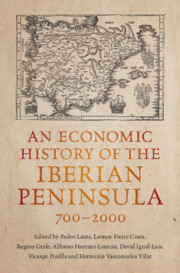Book contents
- An Economic History of the Iberian Peninsula, 700–2000
- An Economic History of the Iberian Peninsula, 700–2000
- Copyright page
- Contents
- Figures
- Tables
- Contributors
- Preface: By Way of Presentation
- Introduction
- Part I The Making of Iberia, 700–1500
- Part II Globalization and Enlightenment, 1500–1800
- Part III Industrialization and Catching Up, 1800–2000
- 18 Economic Growth and the Spatial Distribution of Income, 1800–2000
- 19 Population Growth, Composition and Educational Levels
- 20 Economic Policies and Institutions
- 21 Iberian Financial System, 1800–2000
- 22 Economic Growth and Structural Change in the Iberian Economies, 1800–2000
- 23 Living Standards in Iberia, 1800–2010
- 24 Iberian Globalization and Catching Up in the Poor South European Periphery, 1830–2010
- 25 The Iberian Economy in Comparative Perspective, 1800–2000
- References
- Index
21 - Iberian Financial System, 1800–2000
from Part III - Industrialization and Catching Up, 1800–2000
Published online by Cambridge University Press: 22 February 2024
- An Economic History of the Iberian Peninsula, 700–2000
- An Economic History of the Iberian Peninsula, 700–2000
- Copyright page
- Contents
- Figures
- Tables
- Contributors
- Preface: By Way of Presentation
- Introduction
- Part I The Making of Iberia, 700–1500
- Part II Globalization and Enlightenment, 1500–1800
- Part III Industrialization and Catching Up, 1800–2000
- 18 Economic Growth and the Spatial Distribution of Income, 1800–2000
- 19 Population Growth, Composition and Educational Levels
- 20 Economic Policies and Institutions
- 21 Iberian Financial System, 1800–2000
- 22 Economic Growth and Structural Change in the Iberian Economies, 1800–2000
- 23 Living Standards in Iberia, 1800–2010
- 24 Iberian Globalization and Catching Up in the Poor South European Periphery, 1830–2010
- 25 The Iberian Economy in Comparative Perspective, 1800–2000
- References
- Index
Summary
This chapter covers the history of banking in the Iberian Peninsula from the early nineteenth century to the beginning of the twenty-first century. The narrative provides a complete, albeit brief, historical overview of how the financial structures of the two countries have evolved. It also offers a comparative perspective of the two financial systems, pointing out to their similarities and their differences. The first part of the chapter describes the formation of the Portuguese and the Spanish banking systems. Special attention is given to the main changes that took place since their early beginnings to the consolidation and modernization of the banking structure in both countries. The second part traces the history of the two Iberian central banks: the Bank of Portugal and the Bank of Spain. The last section compares the banking structure and development of the two Iberian nations, and brings out their similarities and differences. First the attention is focused on comparing the main features of the Portuguese and Spanish private commercial and investment institutions. The chapter finishes with a brief evaluation of the historical role played by the Bank of Portugal and the Bank of Spain.
Keywords
- Type
- Chapter
- Information
- An Economic History of the Iberian Peninsula, 700–2000 , pp. 546 - 566Publisher: Cambridge University PressPrint publication year: 2024



